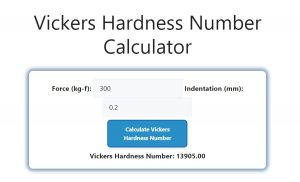About Vickers Hardness Number Calculator (Formula)
The Vickers Hardness Number (VHN) is a crucial measure in material science that quantifies the hardness of a material. It is determined by the size of the indentation left by a specific force applied through a diamond indenter. The Vickers test is versatile and applicable to a wide range of materials, including metals, ceramics, and composites. Understanding the hardness of materials is essential for engineers and manufacturers to ensure that they meet required specifications and performance standards. This article will provide a comprehensive guide to using the Vickers Hardness Number Calculator, along with the formula, practical examples, and frequently asked questions.
Formula
The formula for calculating the Vickers Hardness Number (VHN) is:
Vickers Hardness Number (VHN) = 1.854 * (Force / (Indentation^2))
Where:
- Force: The load applied to the indenter, typically measured in kilograms or Newtons.
- Indentation: The size of the indentation left on the material, measured in millimeters.
How to Use
- Determine the Force: Obtain the force applied to the diamond indenter during the test. This is usually provided in units of kilograms or Newtons.
- Measure the Indentation Size: Measure the diagonal length of the indentation left on the material’s surface after the test. This measurement should be taken in millimeters.
- Insert Values into the Formula: Plug the values of Force and Indentation into the formula.
- Calculate the Vickers Hardness Number: Perform the calculation to obtain the VHN value.
Example
Let’s say a force of 300 kilograms is applied, and the measured diagonal length of the indentation is 0.2 millimeters.
- Force: 300 kg
- Indentation: 0.2 mm
Now, apply the values into the formula:
VHN = 1.854 * (300 / (0.2^2))
= 1.854 * (300 / 0.04)
= 1.854 * 7500
= 13905
The Vickers Hardness Number (VHN) for this material is approximately 13905.

FAQs
- What is the Vickers Hardness Number (VHN)?
The Vickers Hardness Number quantifies the hardness of a material based on the size of the indentation created by a specific force. - How is the Vickers hardness test performed?
A diamond indenter is pressed into the material under a specified load, and the size of the resulting indentation is measured. - What materials can be tested using the Vickers method?
The Vickers test can be used on metals, ceramics, and composites, making it versatile for various applications. - Why is the Vickers hardness test preferred over other hardness tests?
It provides a continuous scale of hardness and can be used on very hard materials, unlike other tests like the Rockwell test. - What units are used for force and indentation in the VHN formula?
Force is typically measured in kilograms or Newtons, and indentation is measured in millimeters. - How accurate is the Vickers hardness test?
The test is highly accurate, with a small error margin, making it reliable for material characterization. - Can the Vickers hardness test be conducted on thin materials?
Yes, the Vickers test is suitable for thin materials, which is advantageous in many applications. - What does a higher Vickers Hardness Number indicate?
A higher VHN indicates a harder material, which is more resistant to deformation and wear. - How does temperature affect the Vickers hardness test?
Elevated temperatures can affect the material’s properties and may lead to changes in hardness readings. - Is there a correlation between Vickers hardness and other hardness scales?
Yes, there are conversion formulas available to relate VHN to other hardness scales, such as Rockwell and Brinell. - How do I ensure accurate indentation measurements?
Use a calibrated microscope or measuring tool to accurately determine the diagonal length of the indentation. - What is the importance of the indenter shape in the Vickers test?
The diamond indenter’s specific shape ensures consistent and accurate indentations across different materials. - Can the Vickers hardness test be used for coatings?
Yes, it can be applied to coatings, although careful measurement and interpretation are required. - What safety precautions should be taken during the Vickers test?
Always use protective gear, and ensure that the equipment is properly calibrated and maintained. - How long does the Vickers hardness test take?
The test itself is quick, often taking only a few minutes, depending on the measurement process. - What factors can influence the hardness results?
Material composition, heat treatment, and surface finish can all affect hardness readings. - Can the Vickers hardness calculator handle multiple test samples?
Many calculators can store and process multiple samples, providing averages or comparisons. - How can I interpret my VHN results?
Compare your results against industry standards or material specifications to assess performance. - Is training required to perform the Vickers hardness test?
While basic training may be helpful, the test can be performed by most technicians with minimal supervision. - What are common applications of the Vickers hardness test?
It is widely used in quality control, material development, and research to evaluate material properties.
Conclusion
The Vickers Hardness Number Calculator is an invaluable tool for assessing the hardness of materials. Understanding the hardness of materials is crucial in various industries, including manufacturing, engineering, and research. By using the VHN formula, you can accurately evaluate materials to ensure they meet specific performance requirements. This guide has provided a thorough understanding of how to use the calculator effectively, along with examples and answers to frequently asked questions to support your material testing needs.